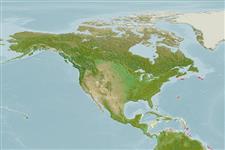>
Anguilliformes (Eels and morays) >
Nettastomatidae (Duckbill eels)
Etymology: Nettenchelys: Greek, netta = duck + Greek, enchelys, -yos = eel (Ref. 45335); inion: From the Greek word inion meaning back of head, occiput, referring to the position of the posterior nostril. Noun in apposition.
Environment: milieu / climate zone / depth range / distribution range
Ecologie
marien bathydemersaal; diepte 458 - 531 m (Ref. 40819). Deep-water
Western Central Atlantic: Bahamas.
Grootte / Gewicht / Leeftijd
Maturity: Lm ? range ? - ? cm
Max length : 42.3 cm TL mannelijk / geslacht onbekend; (Ref. 40819)
Wervels: 210. Posterior nostril at occiput, just in front of supratemporal canal. Median supratemporal pore present. Anterior vomerine teeth not enlarged. Predorsal 37% preanal, head 38% preanal.
Levenscyclus en paargedrag
Maturiteit | Voortplanting | Paaien | Eieren | Fecunditeit | Larven
Smith, D.G., J.E. Böhlke and P.H.J. Castle, 1981. A revision of the nettastomatid eel genera Nettastoma and Nettenchelys (Pisces: Anguilliformes), with descriptions of six new species. Proc. Biol. Soc. Wash. 94(2):535-560. (Ref. 40819)
Status op de Rode Lijst van het IUCN (Ref. 130435: Version 2024-2)
Gevaar voor de mens
Harmless
Gebruik door de mens
Tools
Speciale rapporten
Download XML
Internetbronnen
Estimates based on models
Preferred temperature (Ref.
123201): 8.3 - 9, mean 8.5 °C (based on 7 cells).
Fylogenetische diversiteitsindex (Ref.
82804): PD
50 = 0.5039 [Uniqueness, from 0.5 = low to 2.0 = high].
Bayesian length-weight: a=0.00089 (0.00036 - 0.00222), b=2.98 (2.76 - 3.20), in cm total length, based on LWR estimates for this (Sub)family-body shape (Ref.
93245).
Trofisch niveau (Ref.
69278): 3.4 ±0.5 se; based on size and trophs of closest relatives
Weerstandsvermogen (Ref.
120179): laag, minimale populatieverdubbelingstijd 4,5-14 jaar (Assuming tmax>10).
Fishing Vulnerability (Ref.
59153): Low to moderate vulnerability (32 of 100).
